Introduction
Automated issue resolution is transforming the way developers tackle code-related problems, revolutionizing software development practices. By automating the identification, analysis, and resolution process, these tools are significantly reducing the time and effort traditionally needed to debug and fix issues. The benefits are evident in real-world examples, such as Lex Machina, Delivery Hero, and Hiscox, who have experienced improved efficiency, productivity, and customer satisfaction through automation.
This article explores the advantages, key components, implementation strategies, impact measurement, common challenges, and best practices of automated issue resolution, providing insights and case studies that highlight its transformative potential. By embracing automation and leveraging the right tools, developers can enhance the quality, reliability, and speed of software delivery, ultimately leading to greater efficiency and success in their development workflows.
Understanding Automated Issue Resolution
Automated methods and strategies for problem resolution are transforming the approach developers take to code-related challenges. By automating the identification, analysis, and resolution process, these tools are significantly reducing the time and effort typically required to debug and fix problems. For example, Lex Machina, faced with database management challenges, turned to technology-driven solutions to streamline operations and improve efficiency. Similarly, Delivery Hero dramatically reduced the time employees were locked out of accounts by automating the recovery process. The result? A significant reduction in lost productivity. And let's not overlook Hiscox, who by automating responses to client emails, cut down repetitive workloads and improved response times, enhancing customer satisfaction. These examples demonstrate the transformative influence of resolution of problems, which not only benefits individual developers but also has a ripple effect on the overall efficiency and velocity of program delivery.
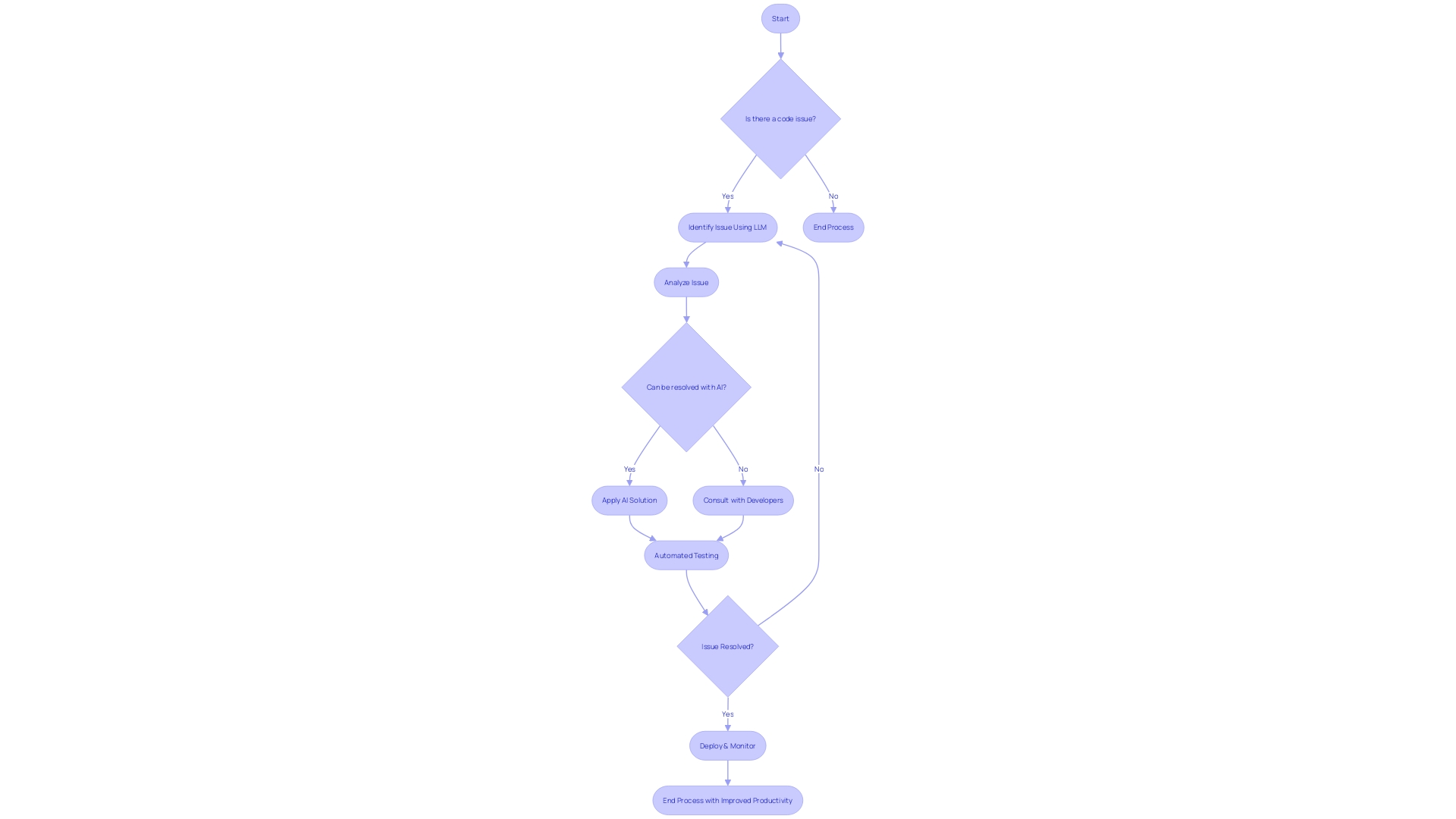
Advantages of Automated Issue Resolution
The merging of automated code analysis and problem resolution technologies is revolutionizing software development practices. These tools enable fast identification and rectification of code problems, surpassing manual endeavors with efficiency and precision. By scrutinizing code at a depth unachievable by human review, they uncover hidden problems and provide developers with clear, actionable guidance. This enables developers to make well-informed decisions and resolve concerns with confidence.
In the technology sector, the influence of automation is clear in the domain of Continuous Integration (CI), where automated merging of code from different contributors is a standard procedure. This automation ensures early detection of integration issues, driving a more efficient and collaborative application development process.
Moreover, the rise of DevOps has brought forth a wave of automation mechanisms aimed at streamlining the development lifecycle (SDLC). These instruments encompass continuous integration (CI), continuous delivery (CD), infrastructure as code (IAC), and more, demonstrating that automation not only expedites delivery but also enhances the precision of software development in line with business objectives.
Illustrating the significance of automation, Thoughtworks' Technology Radar highlights the ever-growing number of technological solutions available to address complex problems. This multitude of options, while advantageous, contributes to the cognitive burden for technologists, rendering the simplification and streamlining provided by automated solutions even more valuable.
Supporting this transition toward automation, statistics reveal that AI pair-programming solutions like GitHub Copilot can notably enhance developer productivity across all skill levels. These AI-driven instruments provide predictive coding suggestions, decreasing the cognitive load and enhancing the enjoyment and quality of the coding experience.
As the development landscape evolves, it's crucial to remember the lessons learned from years of product development: the importance of customer feedback. Whether it's introducing AI in software engineering or any other instrument, engaging with actual users remains a cornerstone for creating solutions that truly resonate with their needs and enhance their workflows.
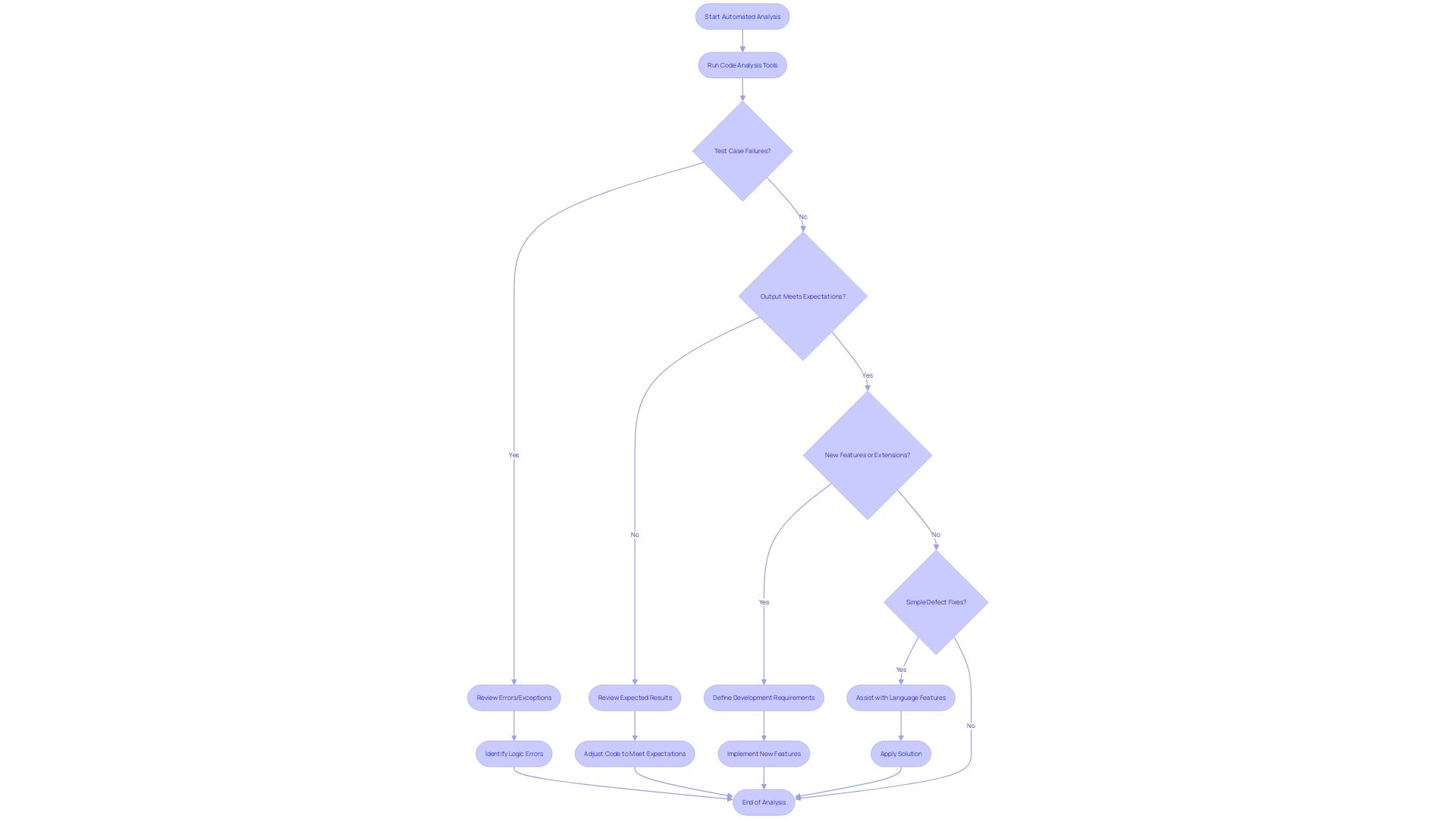
Key Components of Automated Issue Resolution
Comprehending the elements of a system for resolving problems automatically is essential for developers seeking to improve the quality and dependability of their codebase. Such systems frequently incorporate static code analysis, debugging instruments, and automated testing frameworks. Static code analysis assists in identifying potential security vulnerabilities and code smells before they become a problem, much like how TypeScript has evolved over the past decade to incorporate robust type-checking and error detection capabilities. Debugging instruments are essential in isolating and resolving problems that arise, especially in intricate environments where changes can have unexpected outcomes. Automated testing frameworks, encompassing everything from unit tests to integration and load testing, ensure that code behaves as expected even as new features are added or existing ones are modified. This is reflected in the way M&T Bank has approached maintaining their software's quality standards amidst the digital transformation of the banking industry, mitigating the risks of security breaches and financial losses. Similarly, AI-powered software like GitHub Copilot is revolutionizing how developers work by providing real-time coding suggestions, thus reducing cognitive load and improving productivity across all skill levels. By leveraging these elements effectively, developers can address the myriad challenges they face, from simple defect fixes to the integration of new functionalities.
Implementing Automated Issue Resolution in Your Workflow
Automated problem resolution is a transformative approach that streamlines your development workflow, enhancing productivity and code quality. Choosing the appropriate equipment is crucial, making sure they fit your project's specific requirements. By effectively setting up these tools, they can tackle relevant questions that come up during code reviews and pull requests, such as the broader consequences of changes and their connection to existing problems.
Connecting relevant concerns to pull requests is essential, as it illuminates the wider influence of the modifications being suggested. This practice not only aids in identifying and addressing potential conflicts but also facilitates a more comprehensive understanding of the modifications' effects across the project.
An example of this is Kargo's experience with their Node.js projects, where mechanized resolutions greatly reduce the time and energy needed to address problems. This real-world example highlights the tangible benefits of integrating issue resolution systems into the development cycle.
In the landscape of continuous integration and delivery (CI/CD), artificial intelligence (AI) is increasingly becoming integral. AI has the potential to simplify complex tasks within the CI/CD pipeline, replacing manual work, anticipating problems, and ensuring higher quality outcomes. This integration is indicative of the future of DevOps - a future where automated quality controls and detailed insights into code progression are standard.
Incorporating automation technology that aligns with the DevOps framework is crucial. These instruments can automate different phases of the software development lifecycle, reducing overhead and promoting faster delivery. With the right setup, project managers and developers can shift their focus from meetings to more productive tasks, with AI agents handling requirements gathering and ensuring clarity and actionability.
Moreover, AI-enhanced workflows are revolutionizing the developer's experience, making tasks like refactoring code and conducting research far more efficient. AI technologies like GitHub Copilot have demonstrated significant advantages across various productivity aspects, from reducing task time to enhancing product quality.
Adopting the use of technology-driven problem solving is a strategic decision that can result in a streamlined and more effective development procedure. With careful tool selection and configuration, alongside best practices for team collaboration and code review, developers can navigate the complexities of modern software development with greater ease and success.
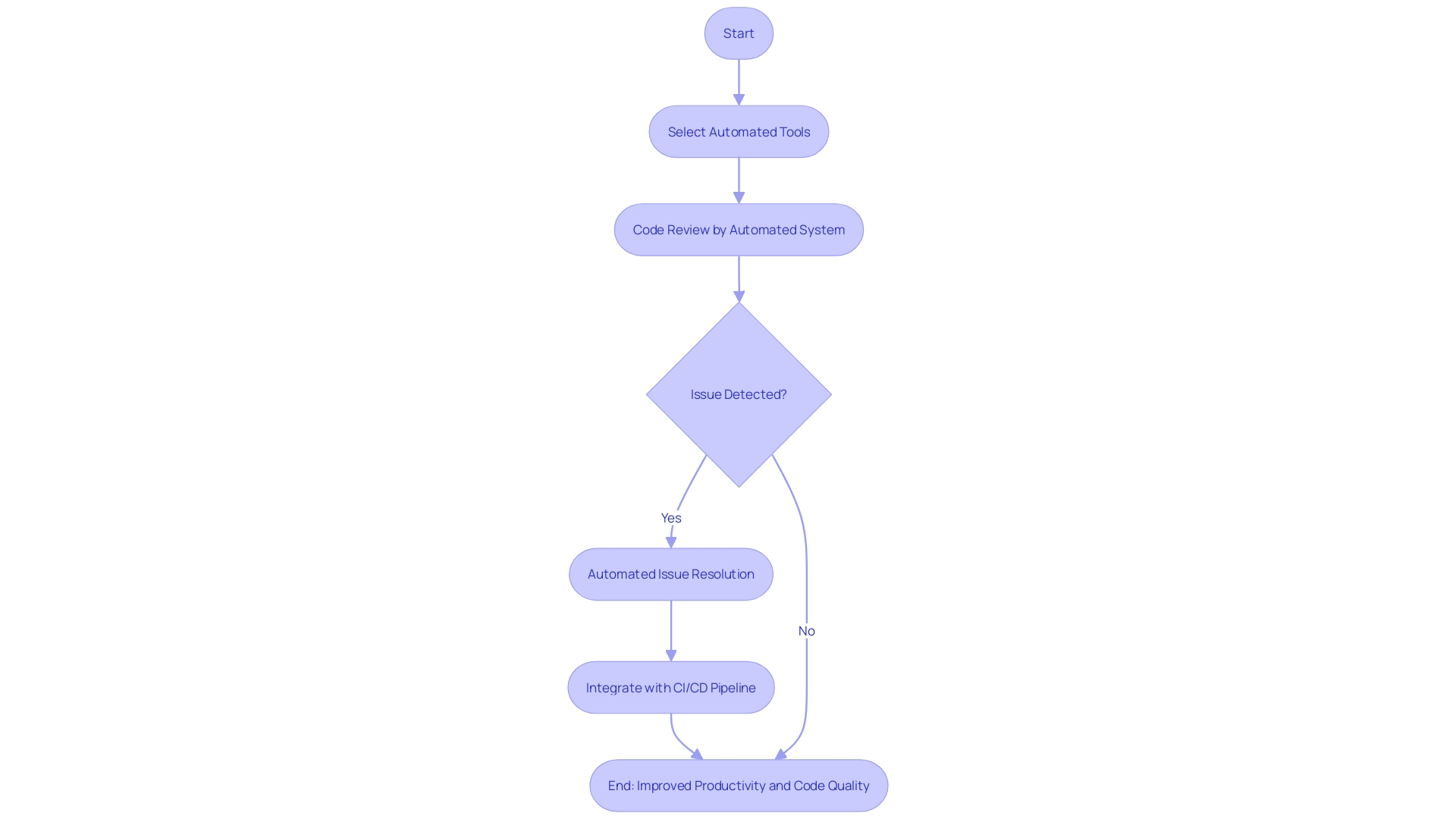
Measuring the Impact of Automated Issue Resolution
To assess the effectiveness of issue resolution, it is crucial to measure its impact using key metrics that indicate improvements in code quality, productivity, and team efficiency. By analyzing these metrics, insights can be derived that not only demonstrate the advantages of technology-driven solutions but also guide data-driven optimizations in the development process. For example, substantial language models (LLMs) utilized in AI pair-programming solutions such as GitHub Copilot have been demonstrated to greatly enhance developer productivity. This is especially true for junior developers, who benefit from AI-driven code suggestions that span a range of productivity aspects, including task time, product quality, and cognitive load.
The deployment of such mechanized mechanisms is crucial in sectors such as banking, where the digital revolution is gaining momentum, and the expense of faulty applications is significant. A case in point is M&T Bank, which has taken proactive steps to establish Clean Code standards across its organization. This strategic move is aimed at maintaining application quality and compliance, which are non-negotiable in the banking sector due to the sensitive nature of data and transactions involved.
Metrics play a crucial part in evaluating the effectiveness of automated problem-solving solutions. An effective set of success criteria must be comprehensive, minimal, written, and falsifiable to ensure they can be reliably measured and tracked. The insights gained from these metrics can be used to make informed decisions that enhance the development process. As an illustration, the expense linked to faulty programs in the United States surpassed $2 trillion in 2022, underscoring the necessity for instruments that can precisely detect and address issues with digital applications. This understanding is further reinforced by empirical studies like those by Allen School professors, who demonstrated that mutantsâartificial defects embedded in a programâcan effectively mimic real defects in testing, thus validating the importance of robust testing protocols.
Ultimately, monitoring subjective measures and leveraging them efficiently is a foundation for enhancing the software development process, minimizing the chance of expensive flaws, and guaranteeing that developers are aided by resources that enhance their work, resulting in higher quality software and increased overall productivity.
Addressing Common Challenges in Automated Issue Resolution
Understanding the complexities of resolving problems using advanced resolution systems can sometimes be as challenging as the problems themselves. Developers encounter various obstacles, from identifying false positives to ensuring smooth integration with their current set of development instruments. For instance, the Digital Service Team in a healthcare trust faced a similar challenge when assessing technology requests. They discovered that much-needed functionalities were already available within existing solutions, a revelation uncovered through meticulous inquiry and assessment processes, highlighting the importance of comprehensive evaluation before adopting new digital technologies.
When it comes to integrating mechanized resolution methods, the necessity for a well-defined approach becomes apparent. Just as the Digital Service Team employs a questionnaire to understand the requester's needs and the technology's alignment with their objectives, developers must also meticulously plan and prepare. This involves defining the scope of automation, choosing the right tools, and setting up a robust framework to support automation. Through this process, the environment is configured to mirror actual production settings, and test data is meticulously prepared and managed.
Furthermore, the notion of continuous integration (CI) is crucial in the context of automated problem resolution. CI encourages developers to merge code changes into a shared repository regularly and automatically, promoting early detection of integration issues. This practice is not only about introducing new resources but also about fostering collaboration and enhancing the overall efficiency of the development lifecycle.
The concerns of decision-makers towards embracing new technologies reflect the sentiments found within the development community. Thought leaders in the field, like Adam Jacob, address these concerns by shedding light on problems like the '200% knowledge problem,' which emphasizes the cognitive overload developers face when bombarded with an abundance of technological solutions. The importance of engaging with actual customers, understanding their challenges, and refining workflows cannot be overstated, as echoed by the findings of our research. The rise of AI in software development has resulted in a multitude of AI-driven solutions, but the importance of developer consultation remains crucial.
To sum up, although automated problem-solving solutions provide the potential for effectiveness and output, the act of embracing and incorporating these solutions must be undertaken with a strategic perspective. By comprehending the challenges, adequately preparing, and fostering an environment of continuous learning and adaptation, developers can make the most of these resources.
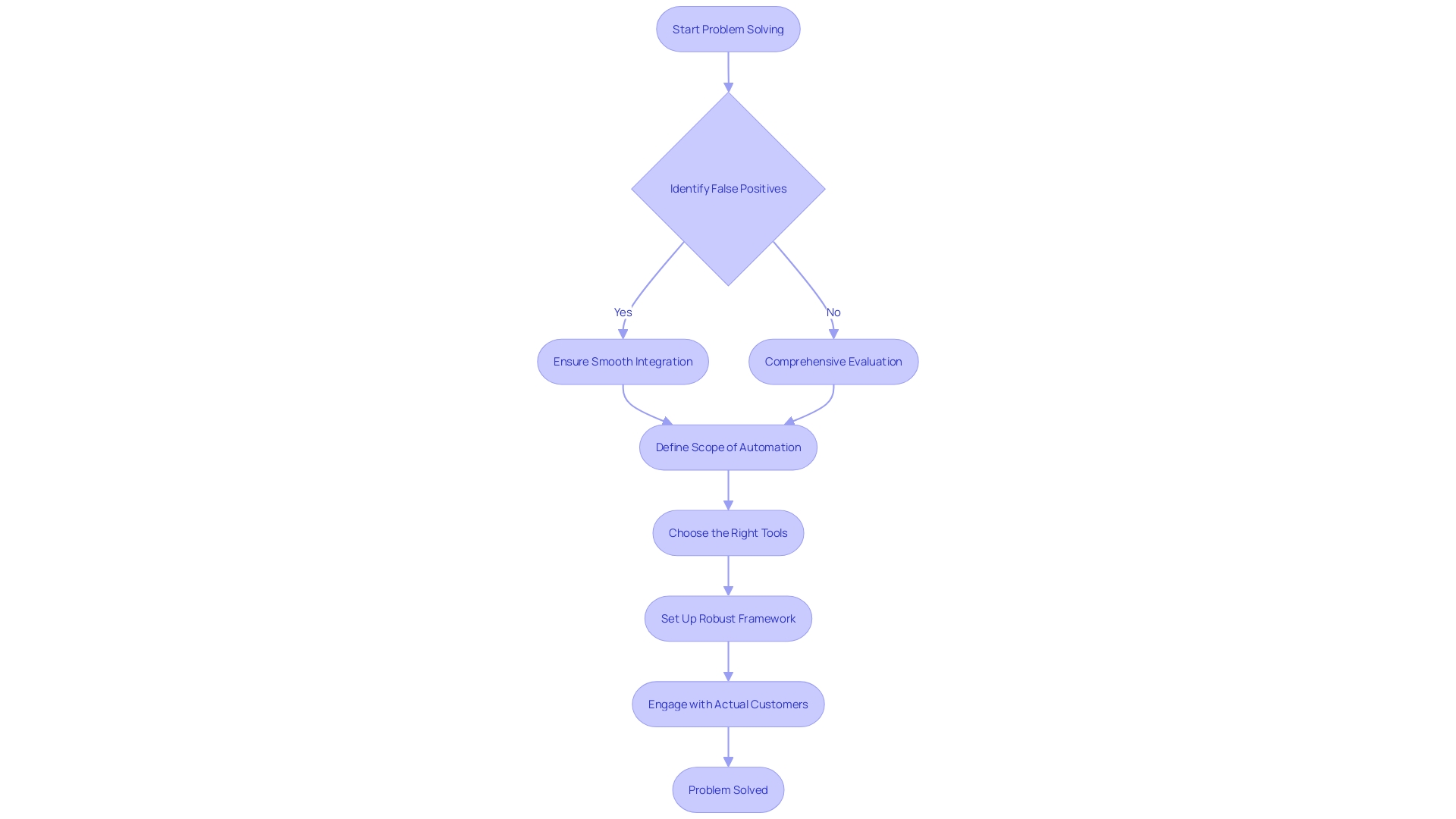
Best Practices for Successful Automated Issue Resolution
Automated issue resolution methods have transformed the manner in which developers handle and control software problems. To harness their full potential, certain best practices are advised. One such practice is the continuous updating of tools and libraries, which maintains the effectiveness of these systems. A case in point is the Department of Electronic & Electrical Engineering's approach to managing student tutorials, where a shift in coordination led to a more streamlined process. Furthermore, companies such as Delivery Hero have shown the worth of systems that are mechanized in minimizing time-consuming duties, such as account recovery, from an average of 35 minutes to a more effective procedure.
Prioritizing issues accurately is also crucial. By adopting a method similar to Hiscox's implementation of an automated solution, which successfully reduced repetitive workload by 28% and improved response times, developers can prioritize more effectively. This aligns with the principles of design patterns and continuous integration, ensuring that the code is not only efficient but also maintainable.
Additionally, incorporating a DevOps mindset, which involves automating the development lifecycle, can greatly expedite delivery and improve the precision of projects. This ecosystem of automation bridges the gap between development, operation, and quality assurance. When considering the automation of core aspects like continuous integration, delivery, and infrastructure as code, it's evident that these practices contribute to a substantial reduction in overhead and a quicker time to market.
To sum up, a holistic approach to problem resolution, guided by the insights from case studies, news, and expert quotes, enhances a more effective and efficient development process. Developers can consult Jones Yeboah's research for guidance on choosing the appropriate static analysis tools, which are essential in enhancing the quality and dependability of both the systems and the development procedures.
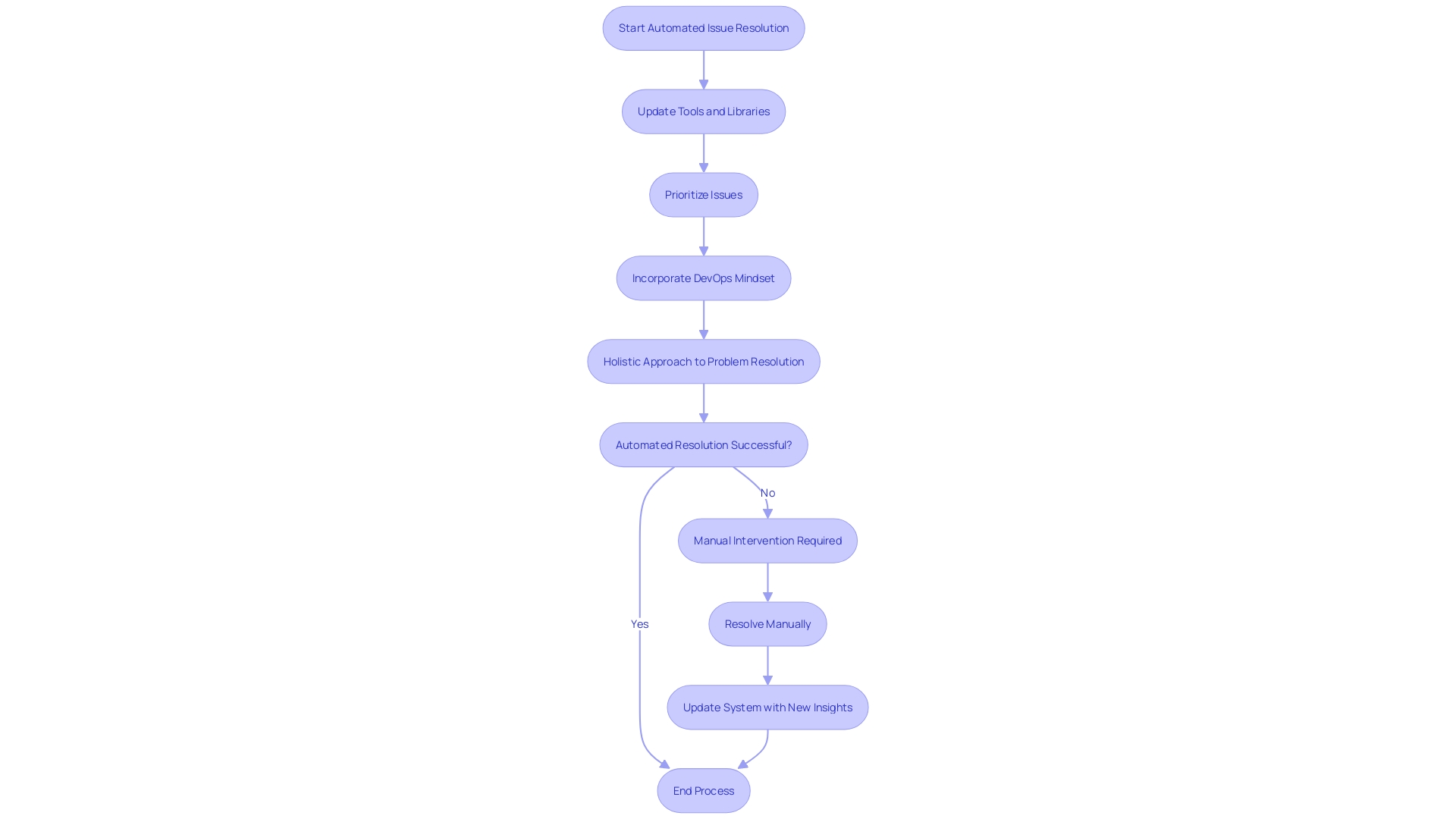
Case Studies: Successful Implementation of Automated Issue Resolution
M&T Bank, a venerable institution with a 165-year history and over 21,000 employees, is a prime example of how the banking industry faces the dual challenges of digital transformation and the need to meet stringent security and regulatory requirements. Their proactive approach in embracing Clean Code standards across the organization underscores the critical role of automated code analysis and problem resolution in maintaining software that is not only efficient and reliable but also secure.
Developers today grapple with a multitude of issues ranging from test case failures to the need for extending existing functionality without clear implementation pathways. Automated solutions are pivotal in addressing these challenges, ensuring that code output aligns with expectations and that defect fixes are executed promptly.
Case studies like that of M&T Bank demonstrate the transformative impact of solutions in a highly regulated industry. Similarly, the integration of a large network of apps and services was a significant hurdle for Lindy, an AI assistant platform. The complexity of developing these integrations from scratch could have delayed their market entry by a year. Nevertheless, automated instruments and approaches, like those suggested by ARUS for eliminating unnecessary stubbings in test suites, can simplify such processes, improve testing activities, and diminish the manual burden on developers.
In the realm of intelligent automation, companies like Tsavo categorize organizations into those fully automating and replacing developer roles and those focusing on augmentation and enhancement. This contrast demonstrates the changing environment where developers' responsibilities are changing but not vanishing, thanks to automation tools that enhance their abilities.
The vision of reducing time spent on requirements gathering and increasing time on actual development is shared by many in the industry. An AI requirements agent that automates the mundane parts of this process is not just a convenience; it's a revolution in making development smoother and more efficient. With such advancements, the once resource-intensive phase of program maintenance is being redefined, as evident from GitHub's research on AI's growth and impact on program development.
In conclusion, the case studies and innovations in automated code analysis and issue resolution tools reveal a trend towards more streamlined, secure, and efficient software development processes, reshaping how banking organizations like m&t Bank and innovative tech companies like Lindy operate in today's digital age.
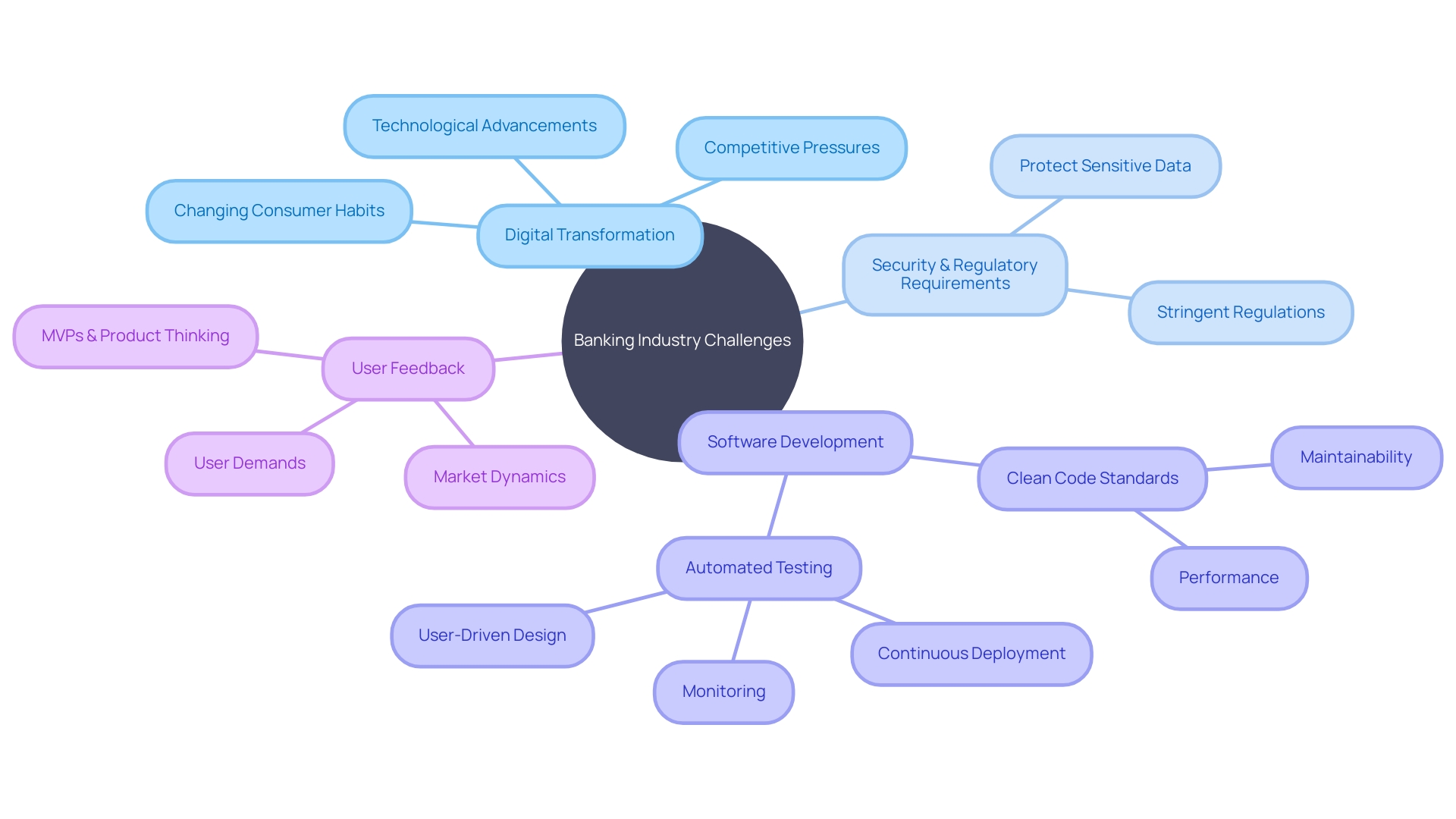
Conclusion
Automated issue resolution is revolutionizing software development by streamlining the identification, analysis, and resolution of code-related problems. Real-world examples from companies like Lex Machina, Delivery Hero, and Hiscox demonstrate the transformative impact of automation, leading to improved efficiency, productivity, and customer satisfaction.
Automation tools offer advantages such as rapid issue identification and correction, surpassing manual efforts with efficiency and precision. In Continuous Integration (CI), automation ensures early detection of integration issues, driving a more efficient and collaborative software development process. In DevOps, automation tools streamline the software development lifecycle, expediting delivery and aligning development with business objectives.
Key components of automated issue resolution systems include static code analysis, debugging tools, and automated testing frameworks. These components assist in identifying vulnerabilities, fixing issues, and ensuring code behaves as expected. Proper implementation of these elements, as seen in the case of M&T Bank, helps maintain software quality standards and mitigate risks.
Implementing automated issue resolution requires careful tool selection and configuration. Linking related issues to pull requests and adopting automation tools within the DevOps framework are crucial steps. Embracing automation leads to more efficient development processes, where AI-driven tools like GitHub Copilot provide real-time coding suggestions and improve productivity.
Measuring the impact of automated issue resolution requires quantifying its benefits through key metrics. These metrics reflect enhancements in code quality, productivity, and team efficiency. Addressing common challenges involves comprehensive evaluation before adopting new technologies and a well-defined approach to integration.
Best practices for successful automated issue resolution include continuous updating of tools, accurate issue prioritization, and integration of a DevOps philosophy. These practices maintain the effectiveness of automated systems, improve efficiency, and enhance the accuracy of software projects.
In conclusion, automated issue resolution tools offer significant benefits in terms of efficiency and productivity. By adopting a comprehensive approach, developers can leverage these tools to streamline their development processes, improve code quality, and meet the challenges of modern software development with ease.
Frequently Asked Questions
What is automated issue resolution?
Automated issue resolution refers to the use of technology-driven methods and strategies to identify, analyze, and resolve coding challenges, significantly reducing the time and effort required for debugging.
How does automation benefit software development?
Automation enhances software development by enabling faster identification and rectification of code problems, improving efficiency, and allowing developers to make informed decisions with confidence.
What are some examples of companies using automated issue resolution?
Lex Machina improved efficiency in database management through automation. Delivery Hero reduced employee lockout times by automating account recovery. Hiscox enhanced customer satisfaction by automating responses to client emails.
What key components are involved in automated issue resolution?
Key components include Static Code Analysis, which identifies potential security vulnerabilities; Debugging Tools, which help isolate and resolve issues; and Automated Testing Frameworks, which ensure code behaves as expected during modifications.
How does automation fit into Continuous Integration (CI) and DevOps?
In CI, automation facilitates the merging of code from different contributors, leading to early detection of integration issues. In DevOps, automation streamlines the software development lifecycle, promoting faster delivery and enhancing project precision.
What role does AI play in automated issue resolution?
AI tools, such as GitHub Copilot, provide predictive coding suggestions that enhance developer productivity, reduce cognitive load, and improve the quality of the coding experience.
How can developers implement automated issue resolution in their workflows?
Developers should choose appropriate tools that align with project requirements, connect relevant issues to pull requests for better understanding, and follow best practices for tool setup and team collaboration.
What metrics are used to measure the impact of automated issue resolution?
Metrics to assess effectiveness include improvements in code quality, productivity, and team efficiency, guiding data-driven optimizations in the development process.
What challenges do developers face when adopting automated issue resolution?
Challenges include managing false positives, ensuring seamless integration with existing tools, and addressing the cognitive overload from numerous technological solutions.
What best practices should developers follow for successful automated issue resolution?
Best practices include continuously updating tools and libraries, prioritizing issues effectively, and adopting a DevOps mindset to bridge development, operations, and quality assurance.
Can you provide examples of successful implementation of automated issue resolution?
M&T Bank uses automated code analysis to maintain software quality and compliance in the banking sector. Lindy streamlined the integration of apps using automated tools, significantly reducing their time to market.
How does automated issue resolution transform the developer's experience?
By reducing mundane tasks and enhancing productivity through AI-driven tools, developers can focus more on actual development rather than on repetitive processes.
Why is customer feedback important in the context of automated issue resolution?
Engaging with actual users ensures that the automated solutions resonate with their needs and improve their workflows, leading to more effective outcomes.




